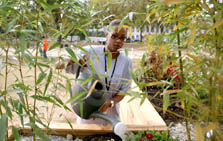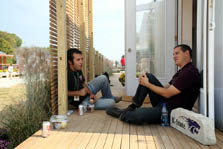
Click photo to view a larger image.


Lunch at the Kansas Project house consists of quick bite and a welcome chance to sit down, if only for a few minutes.

Greg Shoukas, left, of the Decathlon Instrumentation team talks to Ben Barnes of the University of Illinois team about the Hot Water contest. The contest measures whether the teams can deliver 15 gallons of hot water (110°F/43.3°C) in 10 minutes or less on each of four days of the competition.
Solar Decathlon 2007
Daily Journal - October 18, 2007
Illinois Wins Market Viability, Maryland Holds Lead
This sixth day of the competition began and ended with some memorable highlights. This morning, 150 points were on the line with the announcement of the Market Viability contest. Marketability, affordability, and buildability—all important considerations for the housing market—are measured and evaluated as part of this contest. The University of Illinois came out on top.
The excitement at the end of the day centered around the signing of a Memorandum of Understanding with Spain to expand the Solar Decathlon to a European venue. We'll talk more about that later.
The juried portion of the Market Viability contest evaluates market appeal. Those jurors are Jim Ketter with the Tierra Group, Doug Lowe of Artisan Construction, Joyce Mason of Pardee Homes, and Bob Burt of Burt Construction Services, who presented the awards this morning. Other portions of the contest look at economic analysis and planning documents.
Burt began by saying that his 35-year career in the building industry has been based on knowing what is buildable and marketable. He is convinced that people want something different from what the housing market is delivering. With obvious delight, Burt announced the placings for the Market Viability contest:
1st Place, University of Illinois, 114.35 points
2nd Place, University of Maryland, 112.5 points
3rd Place, Penn State, 109.95
Some comments from the jury follow:
Illinois—This house features great modularity. The use of recycled materials is great. The idea of expanding a house over time is very appealing. The passive solar design is well done. The space feels larger than it is—it does not feel cramped, and the two windows at the end of the house expand the space. This house seems like it would not require a lot of maintenance. The team did an excellent job on the economic analysis!
Maryland—This house is very impressive. It features good storage, including plenty of nooks and crannies for storing items. There is a tremendous amount of storage. The laundry area is great and features extra space. The closet area in the bedroom is quite large. This house could be very adaptable, and many different themes could be applied. It would be easy to market. The design team thought about converting elements to serve dual purposes when they could.
Penn State—This is a very, very marketable house that could sell in many different locations. The sliding table/desk feature is very innovative. The flexibility of the moving wall is great. The structural steel assembly is very nice, impressive. The woodwork is "off the chart." It is nice that the team was mindful of using indigenous materials. This house features real-world sized rooms, including the kitchen and bathroom, which is nice to see in such a small house. It's impressive that a working partnership has been established with a real-world builder.
Later in the day, it seems that we went from market viability to market expansion—in the form of expanding the Solar Decathlon concept to Europe. Adjacent to the lot of the Universidad Politécnica de Madrid house, dignitaries, media, and Solar Decathletes gathered for a major announcement. In addition to the regular Solar Decathlon schedule in the United States, with the next event planned for 2009, there will now be a European Solar Decathlon planned for even-numbered years, with the first one scheduled for 2010.
Under Secretary of Housing for Spain Fernando Magro and DOE Assistant Secretary Alexander Karsner shared the honor of announcing this Memorandum of Understanding between DOE and Spain's Ministry of Housing to share the Solar Decathlon name, concept, and rules and regulations in the future.
"We have great hope that the development of a competition of this type in Europe, and taking place in Madrid in 2010, can have the same high level at this edition, and with the confidence that has been passed to us by the Department of Energy, today I sign this Memorandum," said Magro. "Teams from the United States will be very welcome to compete."
"This is a very exciting and historic day," said Karsner. "We hope this expansion of the Solar Decathlon stirs more rapid expansion of these innovative technologies."
So there was lots of excitement today, and more to come tomorrow when the overall winner of the 2007 Solar Decathlon is announced at 2:00 p.m. EST. At day's end today, the competition was too close to call. Although Maryland has a sizable 24-point lead over Darmstadt, and Penn State is another 12 points back, there are major points to be announced tomorrow. It's closer than it looks, and the 150 points for the Engineering contest could make a big difference in the final outcome.
